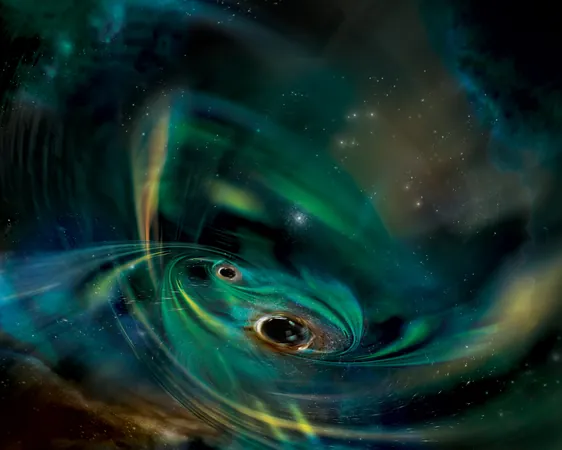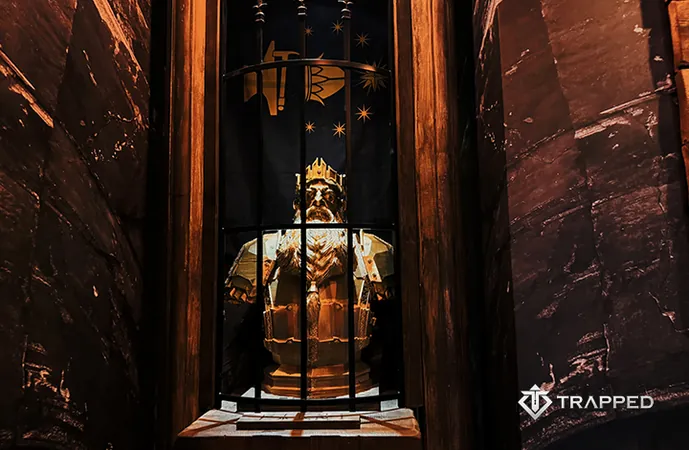
Astronomers Unravel the Mystery of Gas-Churning Monster Black Holes!
2024-11-13
Author: Amelia
Groundbreaking Study Unveils Unique Celestial Event
In a groundbreaking study, researchers utilizing NASA's Neil Gehrels Swift Observatory have unveiled what appears to be a unique celestial event: the signal from a pair of enormous black holes wreaking havoc on a massive cloud of gas at the heart of a distant galaxy.
This peculiar phenomenon, designated AT 2021hdr, is remarkable because it recurs every few months,” explains Lorena Hernández-García, an astrophysicist from the Millennium Institute of Astrophysics in Chile. The researchers believe that a gas cloud is enveloping these black holes. As they orbit each other, the duo interacts with the gas, disrupting and consuming it, which creates a fluctuating light pattern observable from Earth.
Published Findings and Distance
The findings related to AT 2021hdr, with Hernández-García leading the research, were published on November 13 in the journal Astronomy and Astrophysics. The binary black holes are located at the center of the galaxy designated 2MASX J21240027+3409114, about 1 billion light-years away in the northern constellation of Cygnus. Astonishingly, these monstrous black holes, whose combined mass is 40 million times that of our Sun, are situated approximately 16 billion miles (26 billion kilometers) apart—light can travel this distance in just a day!
Orbital Period and Future Collision
Astrophysicists estimate that these black holes complete an orbit every 130 days and predict they will collide and merge in roughly 70,000 years. That's right! A cosmic event that sounds like it belongs in a sci-fi movie could take place long after humans are gone!
Initial Observations
The first signs of AT 2021hdr were observed in March 2021 by the Zwicky Transient Facility (ZTF) at California's Palomar Observatory. Initially identified as a potential supernova event, subsequent observations revealed a more intricate story. With each outburst detected in 2022, we reconsidered our initial assessments,” adds co-author Alejandra Muñoz-Arancibia, a member of the ALeRCE team and fellow astrophysicist.
Monitoring and Data Analysis
Continuously monitored by ZTF, outbursts from AT 2021hdr have been recorded every 60 to 90 days since that initial detection. Utilizing Swift, Hernández-García and her team have identified that the binary system also produces oscillations in ultraviolet and X-ray light, in sync with what ZTF observes in visible wavelengths.
Ruling Out Explanations
The team meticulously ruled out several explanations for the observed data. While the activity might have seemed initially like standard behavior from a galactic center, they later considered the possibility of a tidal disruption—specifically, the destruction of a star straying too close to one of the formidable black holes. Ultimately, they concluded that the gravitational pull from the black holes was tearing apart a much larger gas cloud, leading to hot, dense filaments forming around them and resulting in the fluctuations in brightness that both Swift and ZTF have been monitoring.
Cosmic Dance of Black Holes
As the binary system continues to spiral around each other, the intricate dynamics cast some gas out of the system with each rotation, manifesting as the variating light captured by observer instruments.
Future Explorations
In the coming months, Hernández-García and her team plan to further explore AT 2021hdr to deepen their understanding of this extraordinary cosmic dance. They are also keen to study its host galaxy, which is currently undergoing a merger with a neighboring galaxy—a detail first noted in their publication.
Celebrating Swift's Achievements
With Swift nearing its 20th anniversary, it’s astonishing to see the wealth of scientific discoveries it still enables,” remarked S. Bradley Cenko, Swift's principal investigator at NASA's Goddard Space Flight Center. “There’s an endless array of insights the universe still holds, and we're just beginning to scratch the surface!
Continuing the Quest for Cosmic Knowledge
NASA's relentless quest for knowledge about the cosmos is part of a larger, global initiative dedicated to uncovering the mysteries that govern our universe. This discovery could potentially reshape our understanding of black hole interactions and the behavior of galactic matter, so stay tuned—who knows what cosmic marvels await exploration!









 Brasil (PT)
Brasil (PT)
 Canada (EN)
Canada (EN)
 Chile (ES)
Chile (ES)
 España (ES)
España (ES)
 France (FR)
France (FR)
 Hong Kong (EN)
Hong Kong (EN)
 Italia (IT)
Italia (IT)
 日本 (JA)
日本 (JA)
 Magyarország (HU)
Magyarország (HU)
 Norge (NO)
Norge (NO)
 Polska (PL)
Polska (PL)
 Schweiz (DE)
Schweiz (DE)
 Singapore (EN)
Singapore (EN)
 Sverige (SV)
Sverige (SV)
 Suomi (FI)
Suomi (FI)
 Türkiye (TR)
Türkiye (TR)